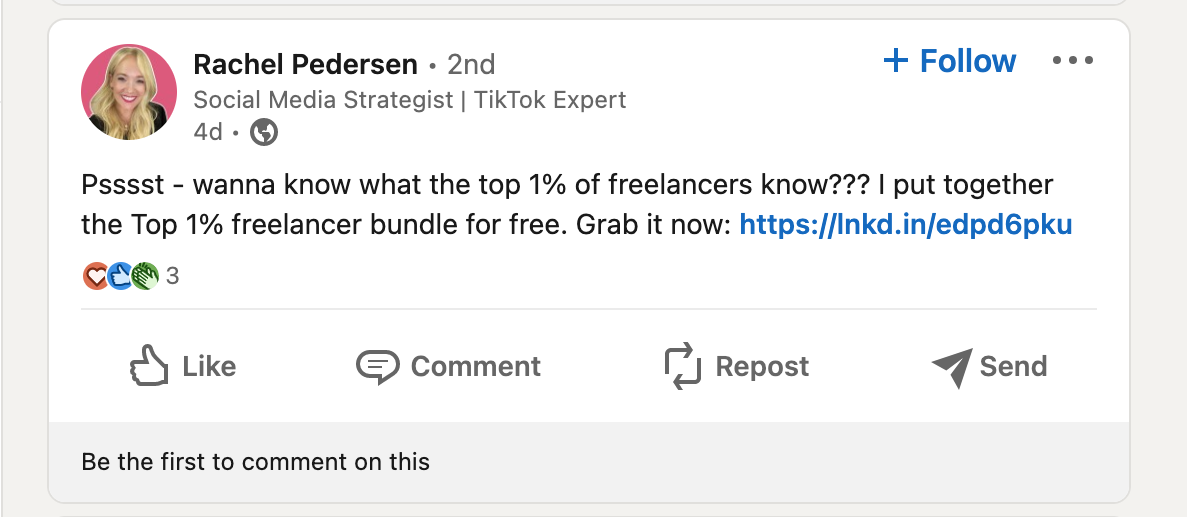If you’re tired of cold calling and crafting sales pitches to generate new leads for your business but love using social media, then social selling will be your new favorite thing.
Social selling is a concept that’s very effective in helping brands find potential buyers and build trust, but it’s often overshadowed by social media marketing and social media advertising. While these strategies all have some things in common (all happen on social media platforms), they are three different things that most successful businesses should utilize.
So, if you want to learn everything you need to know about social media selling and how it can help you grow your business in 2023 and beyond, let’s dig in.
What is social selling?
Social selling is a method of finding new prospects interested in your business by connecting and engaging with them on various social media platforms.
One of the reasons social selling is fantastic for many brands and businesses is that it eliminates a lot of the negative aspects of old-school sales methods. In the past, sales reps relied on cold calling or emailing to reach the right people to sell a product or service. With social selling, brands spend time building meaningful connections with their prospects, so when it’s time to make a sale, people are much more receptive to it.
In short, social selling is a modern relationship builder with your target audience.
{{socialmedia-component="/blog-shortcodes/blog-popup"}}
What is social selling the inbound way?
Now, social selling in the inbound way means that due to your social selling efforts, the customer comes to you. Here are a few examples of what social selling the inbound way looks like:
- A prospective customer/client/student finds you on LinkedIn through your posts and asks to connect with you.
- A prospective customer/client/student asks you questions in the comments sections under your posts or directly in your DMs.
- A prospective customer/client/student regularly engages with your content on one or more social platforms.
Effective social selling allows you to be found when you are sharing valuable and helpful content to your audience. All social media platforms reward engagement and promote those posts and creators who have high engagement. The best way to generate more engagement on your posts and reach more people is to create content that touches on people’s pain points and resonates with them in some way.
Social selling isn’t just plain marketing. It’s meaningful relationship-building in hopes of quality lead generation.
What is the social selling index?
Social selling index, otherwise known as LinkedIn social selling index or simply SSI, is a metric that brands and individuals use to measure how successful their social selling strategy is. LinkedIn was the first to introduce the concept. The success of your social selling strategy is measured by looking at four skills:
- Establishing a professional personal brand with an optimized profile.
- Finding the right prospects for your business
- Sharing relevant, value-packed content
- Building and strengthening long-lasting relationships
Anyone using LinkedIn for work can see their SSI. Simply sign into your account and go to the LinkedIn Sales Navigator (one of the most valuable social selling tools) and find the Your Social Selling Index page. Having these numbers can help you improve your social selling skills and see which points of your business you should be focusing on more.
Social selling examples
To better understand what social selling looks like in a few different ways, let’s look at a few great examples:
Jenna Kutcher
Jenna Kutcher has grown her podcast to 80,000,000 downloads in the last seven years. All due to her smart social selling strategy. She has built a loyal following sharing her honest journey from working a corporate job to then starting a wedding business. And then on to becoming an educator, teaching people how to start and market their own businesses.
Throughout the years, she has built a loyal customer base that buys her $700+ courses by sharing her life and struggles. She has shared personal moments like miscarriages, her struggle with body confidence, and much more, which helped her connect with her audience and build trust.

Glossier
Glossier is an American beauty brand that is excellent at social selling. They have a dedicated community of customers who buy their products and rave about them any chance they get. And Glossier supports its customers in return by showing them that they listen and they care.
One of the ways Glossier utilizes social selling is by using user-generated content on their social media accounts. Since the very start of their brand, they have been encouraging people to share how they use Glossier products, and they have created multiple branded tags that they encouraged people to use.

This very effective social selling strategy allows Glossier to build a strong relationship with its customers. People are excited to engage with the brand because of the chance to be featured on their Instagram account (which has over a few million followers!) and to be part of a community that shares a love for beauty products.
Rachel Pedersen
Rachel Pedersen is a social media strategist with amazing social selling skills, particularly on LinkedIn. She has built her career by knowing exactly who her audience is and speaking directly to them. In her LinkedIn posts, she always addresses any pain points her target audience has, and then she offers a solution to their problems.

Identifying your target audience is the key to an effective social selling strategy. Pedersen knows exactly what her audience is interested in, what language it speaks, and with what they need help. This allows her to craft compelling content that converts.
Best social selling platforms
Every social media platform has the potential to be a great platform for social selling. Which one you’ll choose will depend on a few factors. Consider what type of content you enjoy creating, what industry you’re in, and where the majority of your target audience hangs out:
- LinkedIn: It’s the best B2B platform where people are looking to build their personal branding. It’s also popular for people looking to showcase their knowledge and expertise to expand their network, find new prospects, employees, and employers. It has a set of tools created with industry professionals in mind to help them find the perfect person for the job.
- TikTok: The newest social media platform and the fastest growing. TikTok is perfect for business owners looking to reach their customers and have a chance to go viral. Due to the app’s unique algorithm, every video has a chance to go viral, increasing businesses’ chances of reaching their target audience. It has a younger user base. However, more and more people from older generations are starting to use the platform as well.
- Facebook: The biggest social media platform in the world, Facebook has a lot to offer when it comes to social selling. It allows you to communicate with your customers and update them on what’s going on with your business. Plus users can do Lives and create and manage private groups so you can easily nurture the relationship in a closed-off environment and create a community.
- Twitter: This short-form platform is great for handling customer service and catching up with industry professionals in a more casual, laid-back environment.
- YouTube: A long-form video content platform (or search engine, more accurately) is perfect for educational purposes. If you have products to showcase and explain to make it easier for your audience, then being on YouTube can add a lot to your business and make social selling so much easier.
How to sell on social media
Different social media platforms will require you to make small tweaks to your social selling strategy:
Social selling tips for Linkedin
1. Optimize your profile
Optimizing your profile on LinkedIn is crucial for success. Adding keywords to your LinkedIn headline ensures that your profile is found in search by people in your network. Because you want to connect with the right people, optimizing your profile will help you do that.
Another important thing is to include a current high-resolution picture as your profile picture. It should be professional and simple. Showcasing to the people who come across your profile that you are someone they can trust.
It’s also important to update your work experience. And go into detail on the skills you used and developed and what sort of projects you were working on in each workplace. Just with one quick glance, this will allow people to get to know your experience and legitimacy.
2. Build credibility
Credibility is one of the key pillars of social selling. LinkedIn is a great platform with multiple tools to help you do that with ease. You have a few options here:
- Ask for testimonials: Request that people you’ve worked with in the past leave you a public testimonial. This should speak to your skills and professionalism. It’s a great way to showcase that you are an expert and have someone vouch for it.
- Ask for endorsement: LinkedIn allows other people to endorse your skills, which further builds your credibility and authority as an expert in your field. So, don’t hesitate to ask for endorsements and endorse other people you’ve worked with in the past.
- Post content: Being active on social media and posting high-quality content is a surefire way to build credibility, and LinkedIn is no exception. You can post short posts or opt for posting longer-form content on your LinkedIn blog. The platform even allows you to upload videos, so whichever form of content you prefer, you have options.
3. Expand your network
And lastly, LinkedIn is the perfect place to connect with the right people and potential customers/clients/students. So, spend time researching people in your field and connect with them on LinkedIn. The platform has plenty of tools to make your search easy. And sending personalized networking requests increases the chances of people accepting your invitation.

Social selling tips for Twitter
1. Optimize your profile
Optimizing your Twitter profile is a crucial first step. You have a very limited space to do so. So really take your time to craft a compelling bio that tells people who you are, what you do, and why they should interact with you.
Also, make sure you have a professional profile picture and an on-brand Twitter banner. It should tell people more about you as a person or your brand. You have space for one link in your bio, so use it wisely.
If you have a business website, link to it. If you have more than one important link to share, then utilize social media tools like LinkTree. It allows you to create a landing page with multiple links which you can place in your Twitter bio.
2. Engage in conversations
The best way to get discovered on Twitter is by engaging in important industry conversations that happen on the platform. Search hashtags and visit the Trending page to get a feel of what is happening in your industry. Engage in relevant conversations and interact with people to get noticed.
3. Post often
Twitter is a rapidly moving platform that encourages its users to tweet often. The post length is shorter than on other platforms, so tweeting often is not that hard. A smart way to post on social media is to repurpose content from other social platforms (for example, LinkedIn) and post it in short, bite-sized pieces as multiple tweets.
Social selling tips for Facebook
1. Share valuable content
Create and post high-quality, value-packed content people will find helpful on your Facebook Page. People will be able to interact with it, so ask questions and encourage engagement. The better the content you share, the higher the chances of people sharing it with others on Facebook.
When crafting your content, use power words to attract the eye to your posts. These help trigger emotions in people, which increases the chances that they’ll stop scrolling and pay attention to what you have to say.
2. Engage
Put yourself out there and engage with other business pages and with people in your comments. Social selling is all about being social and interacting with other people. So, whenever you have a chance to engage with someone on Facebook, do it!
Social selling FAQ
Let’s answer some of the most frequently asked questions people have about social selling.
What are examples of social selling?
There are many forms of social selling, just as there are many ways we build a relationship with people in real life. However, if you are looking for inspiration on how to use social selling in your social media strategy effectively, here are a few social selling examples anyone can use:
- Sharing personal stories: One way to build a connection with your audience is through your own personal experiences. Share any obstacles and hardships you’ve overcome or lessons you’ve learned. It’s a great way to allow your audience to relate to you and start building trust.
- Giveaways: Giveaways are a great tool to offer value to your audience. Create an offer that they would value and find irresistible, and invite them to share it with their friends who would also find the offer useful in their lives. Also, giving back to your community through giveaways is a great way to show them you care.
- User-generated content: Encourage your audience to share them using your products or services on social media and tag you. Use the content that your audience posts about your brand on your social media. It’s an effective way to showcase to your audience that you care and pay attention to them, which builds trust and relationships.
- Testimonials: Testimonials and reviews are the best sales tools, and they also can serve as a way to build trust and relationships with your audience. Share any positive testimonials you receive from your customers/clients/students, and show your audience that you pay attention to what they’re saying.
What are the 4 pillars of social selling?
The four pillars of social selling are:
- Establish a professional brand: Spend time optimizing your social media profiles and hone in on what is your personal brand and how you can make it recognizable and trustworthy.
- Connect with the right people: Before you get started, define your ideal target audience in as much detail as you need. Knowing who you will be selling to and learning their pain points is crucial for successful social selling.
- Provide value: build trust and your brand awareness by sharing valuable content your target audience wants to see and can find helpful or interesting in some way.
- Build with a long-term vision in mind: Consistency is the key trait to have if you want to build a long-term business that thrives and can easily generate new leads. So, show up for your audience every day and establish yourself as an authority in your industry.
All four strategies are crucial for successful social selling, and incorporating them into your marketing repertoire will help you in building relationships, so you don’t have to rely on a sales team to bring in new leads to your business.
Join more than 150,000 creators who use Teachable to make a real impact and earn a real income.


%201%20(1)%20(1).png)

.png)
.png)


